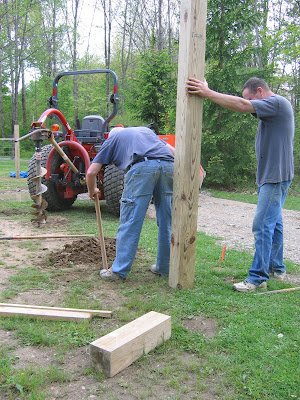Half of the raised beds are in! All in one afternoon/evening.
Step #1. Level the ground. Of course, we are working on a slope, so we are going to step the level of the beds down as we go. We used a string line to keep the two sides in line with each other. A line level ensured the string was level, and we measured down from that to show us if we have any major dips that could be filled in beforehand.

Step #2. Roll out the landscape fabric, cut out for the posts, and pin to the ground with galvanised nails in the corners.

Step #3. Lay out the landscape ties, measure and level obsessively, use gravel to shim up the low corners, as well as to fill in any voids between the tie and the ground. Measure and level obsessively (again). Remind husband this is not finished cabinetry. We centered each bed with the fence panels. This gives me plenty of room between beds, even when things begin to fill out and grow over the edge. Centering on the panels reduced the necessary math calculations to simple ones, and looks good from outside.

Step #4. Drill through the corner lap. (Tim, I was so glad you just eyeballed this instead of measuring the center of each lap.) We also pinned the middle of each long side.

Step #5. Drive rebar through the corner, and into the ground 10 inches. Check again for level (since pounding tends to change this) and re-shim with gravel.

Step #6. Cut the landscape fabric out of the center and till up the very hard packed ground. We are using these cutouts down the center walkway, so there is no waste.

Step #7. Repeat steps 1-6 twelve times.... the first two beds took twice as long as the others. I don't know if we got better as we went along, or just realised this is not finished cabinetry... nor will we be hanging drywall, wall papering, or expecting these beds to remain perfect year after year. But despite the roughness and sometimes poor quality of the ties, every diagonal measured right on. One thing I can say... they ain't goin' nowhere.
Step #8. Add pea stone to the walkways, and bring in topsoil and compost. We did this as we went along, since once you move on to the next bed, there is no way to use the tractor. And the tractors sure made things easier. We used the big tractor to haul materials in, and the little tractor to throw clay clumps and sod into. The compost is like a luxurious carpet. It came from the horse barn, has been turned and aged for a year, and added to with kitchen waste. I did have a few "What'sit" moments but it's amazing how quickly and thoroughly things break down into beautiful black soil.

Step #9. Make yourself a drink, and sit back and enjoy the view.
Step #10. Start again tomorrow. 6 more beds to put in, then the center walkway with the large pavers, and finally the fourth side of the fence will be completed. We will still be able to get the smaller tractor through the gates and up the middle to add compost each year. Tim will be on his own for the rest of the week. Today was an eight hour day for the two of us, and neighbor Mike came and helped for several hours which was good because Tim has been working like this since the beginning of March, and I would have been happy to be done after about 6 hours. But, all went well. I knocked some skin off one knuckle, and Mike got a splinter, but no one's toes were sledge hammered, and my back still goes up and down. Not a bad way to spend a beautiful sunny day. I really would take this over office work as long as the weather is like this.
















